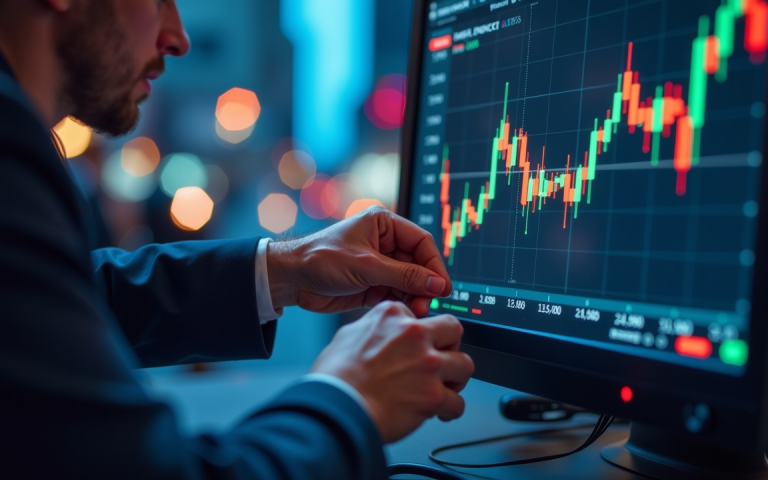European stock markets presented a mixed picture at Wednesday’s open, with indices largely treading water as investors took a moment to digest a fresh batch of corporate earnings and pivotal inflation figures following a period of notable gains.
The early session saw a cautious optimism prevail, even as some benchmarks slightly retreated.
At 03:05 ET (07:05 GMT), Germany’s DAX index edged up by 0.3%, displaying modest strength.
In contrast, France’s CAC 40 traded largely unchanged, reflecting a holding pattern, while the UK’s FTSE 100 experienced a slight dip of 0.1%.
This stabilization comes after a period where renewed investor confidence, buoyed by positive macroeconomic developments, had propelled markets higher.
Volatility subdues as trade truce calms nerves
The recent easing of market turbulence can be significantly attributed to the welcome news of a trade agreement between the United States and China, the world’s two economic titans.
This development has enabled most major equity markets to successfully “claw back the losses they suffered in the wake of U.S. President Donald Trump announcing his tariff plans.”
Consequently, US stocks have returned to positive territory for the year, and their European counterparts are now trading a shade higher than on April 2, the so-called ‘Liberation Day’.
With volatility receding, trading is returning to a more predictable rhythm, allowing investor focus to pivot towards fundamental drivers such as incoming economic data and quarterly corporate performance.
Inflationary winds: German prices cool, ECB eyes further easing
On the economic data front, a key release from Germany indicated a further moderation in inflationary pressures.
The federal statistics office confirmed on Wednesday that German inflation eased to 2.2% in April, aligning with preliminary figures.
This marks a decrease from March, when German consumer prices, harmonised to compare with other European Union countries, had risen by 2.3% year-on-year.
Market participants are now keenly awaiting equivalent Spanish inflation data later in the session, to be followed by French inflation numbers and crucial eurozone growth data for the first quarter on Thursday.
These figures will undoubtedly feed into the deliberations of the European Central Bank, which has cut interest rates seven times in the past year, and is widely expected to continue this cycle at its next meeting in early June.
Echoing this sentiment, ECB policymaker Francois Villeroy de Galhau suggested that conditions remain favorable for further monetary easing.
In a French newspaper group interview on Tuesday, Villeroy, who also heads the Bank of France, stated, “There is room for another rate cut by the European Central Bank by the summer.”
He further elaborated on the divergent inflationary outlooks, telling the EBRA newspaper group, “We also don’t see inflation picking up. The Trump administration’s protectionism will lead to a restart of inflation in the United States, but not in Europe, which will likely allow for another rate cut by the summer.”
Corporate scorecard: earnings season delivers diverse results
The technology sector in Europe was poised for attention on Wednesday, following significant announcements from US chip giants Nvidia (NASDAQ:NVDA) and Advanced Micro Devices (NASDAQ:AMD) regarding substantial artificial intelligence deals in the Middle East.
Elsewhere, the corporate earnings landscape presented a varied picture:
- British luxury purveyor Burberry (LON:BRBY) cheered investors by reporting fourth-quarter sales and an adjusted operating profit for its full year that surpassed market expectations.
- German energy behemoth E.ON (ETR:EONGn) announced an impressive 18% increase in adjusted Ebitda for the first quarter of 2025, attributing the growth to higher investments and improved operational performance across its core business segments.
- Spanish construction firm Ferrovial (BME:FER) posted a robust 19% rise in first-quarter core earnings, largely driven by a strong showing from its toll highway business in the United States.
- Danish pharmaceutical company Lundbeck (CSE:HLUNb) revised its full-year revenue and earnings guidance upwards after reporting a solid 16% increase in first-quarter revenue.
- In contrast, Spanish telecommunications company Telefonica (NYSE:TEF) reported a significant first-quarter net loss, a consequence of write-downs related to the value of its units sold in Peru and Argentina.
- French train manufacturer Alstom (EPA:ALSO) provided an optimistic outlook, forecasting a rise in its adjusted operating margin for the 2025/26 financial year, after reporting annual free cash flow that comfortably exceeded market expectations.
Crude oil eases as US inventories swell
In the commodities market, oil prices edged lower on Wednesday, retreating from a recent two-week high.
The pullback was attributed to a sharp increase in US oil inventories, which stoked concerns about demand.
At 03:05 ET, Brent futures slipped 0.5% to $66.32 a barrel, while US West Texas Intermediate crude futures fell 0.5% to $63.38 a barrel.
Data released on Tuesday by the industry body American Petroleum Institute revealed that “US crude stocks rose 4.3 million barrels in the week ended May 9.”
Investors are now awaiting official weekly inventory figures from the US Energy Information Administration, due later in the session, which could indicate that the demand side is still grappling with significant challenges.
This downturn follows a period of strength for crude, with both benchmarks having climbed more than 2.5% in the previous session, adding to Monday’s gains, after China and the US, the two largest crude consumers, agreed to pause their trade war for at least 90 days while cutting their respective tariffs.
The post Europe markets open: stocks hold steady as German inflation cools, ECB rate cut looms appeared first on Invezz










